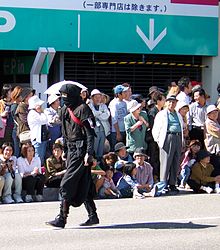Ninja
![]()
This article or subsequent section is not sufficiently supported by evidence (e.g., anecdotal evidence). Information without sufficient evidence may be removed in the near future. Please help Wikipedia by researching the information and adding good supporting evidence.
This affects the whole article. Currently, not a single statement is substantiated.--Empro2 13:16, 6 Dec. 2010 (CET)
![]()
The title of this article is ambiguous. For other meanings, see Ninja (disambiguation).
A ninja [ˈnɪndʒa] (Jap. 忍者, German: 'Verborgener') or shinobi (忍, literally: 'concealer') is a specially trained fighter of pre-industrial Japan who was used as a scout, spy, saboteur, or assassin. Female ninja are called kunoichi. Ninja, like the samurai (jap. 侍), are among the best-known figures of ancient Japan, though a distinction must be made between actual history and later reinterpretation and distortion of terms.
According to modern historical understanding, espionage has always been an integral part of Japanese feudal warrior culture. The Bushidō (jap 武士道) warrior code was not written down until the 19th century, and so with the romanticization of the past in Japan in the 19th and especially 20th centuries, an apparent contrast developed between the "honorable" samurai and the "dishonorable" ninja, mainly as a dramaturgical effect for theater and film stories. The 20th century saw a veritable ninja boom several times: once in the 1920s in novel form, and then again in the 1950s and 1960s, as well as in the 1980s with cheaply produced films such as American Ninja. At this time, commercial martial arts schools also increasingly offered a discipline called "Ninjutsu" (Jap. 忍術). Especially through the modern mass media, a distorted, romanticized image of the ninja reached the West without being historically scrutinized. A precise distinction must be made between the historical use of spies and the modern image of the black-clad assassin.
Reliable historical sources about ninja hardly exist. There are, however, various secret doctrinal texts for ninja that were created from the 17th century onwards, of which the three best known are the Bansenshūkai, the Shoninki and the Ninhiden. In most serious works on Japanese history, however, ninja are left out - in contrast to the samurai, whose historical significance is undisputed and on which there are dozens of well-founded research papers.

Japanese in ninja costume at a parade

Depiction of a Ninja by Katsushika Hokusai, woodblock print from 1817
Origins of Japanese espionage
The beginnings of the ninja can not be clearly determined. It is also difficult to research the historical "art of espionage", its emergence and function throughout history, as secrecy was and still is the most important feature of espionage activity.
The term ninjutsu, or shinobi-no-jutsu, may have originated during his reign, although the original form of ninjutsu may have been purely scouting. It was not until the Heian period (794-1192) that ninjutsu began to become more specialized as part of the Bushi's war strategies. Due to the insei system introduced by Shirakawa, it is considered extremely likely that the ninja were recruited from the ranks of the Sōhei and Yamabushi.
During the rise of the military aristocracy in the 12th century, many successful army leaders employed ninja, although at that time they were called differently (e.g., rappa, kusa, suppa, or the like, depending on whether they were used for sabotage, assassination, or reconnaissance). Although there were already samurai at this time, the warriors were generally called bushi (fighters). These warriors consisted of the numerically small class of noble samurai, below them the foot soldiers (ashigaru) and below them peasants who could be called to arms in case of war. This did not change until the end of the 16th century, when the four estates (Shinōkōshō) of warriors, peasants, artisans and merchants were strictly separated.
Famous Ninja
In Japanese history there are a number of personalities who are counted among the ninja. Often narratives about them are romanticized; it is not always easy to distinguish between legend and truth.
- Fuma Kotaro: Actually several people who served the Hōjō family and led a special fighting force there.
- Hattori Hanzō: Famous ninja from Iga who worked for Tokugawa Ieyasu in counterintelligence.
- Ishikawa Goemon: Notorious thief and folk hero of the Japanese Middle Ages
- Sarutobi Sasuke: According to the tale, a ninja from Kōga who served Sanada Yukimura. His actual existence is disputed.
Search within the encyclopedia